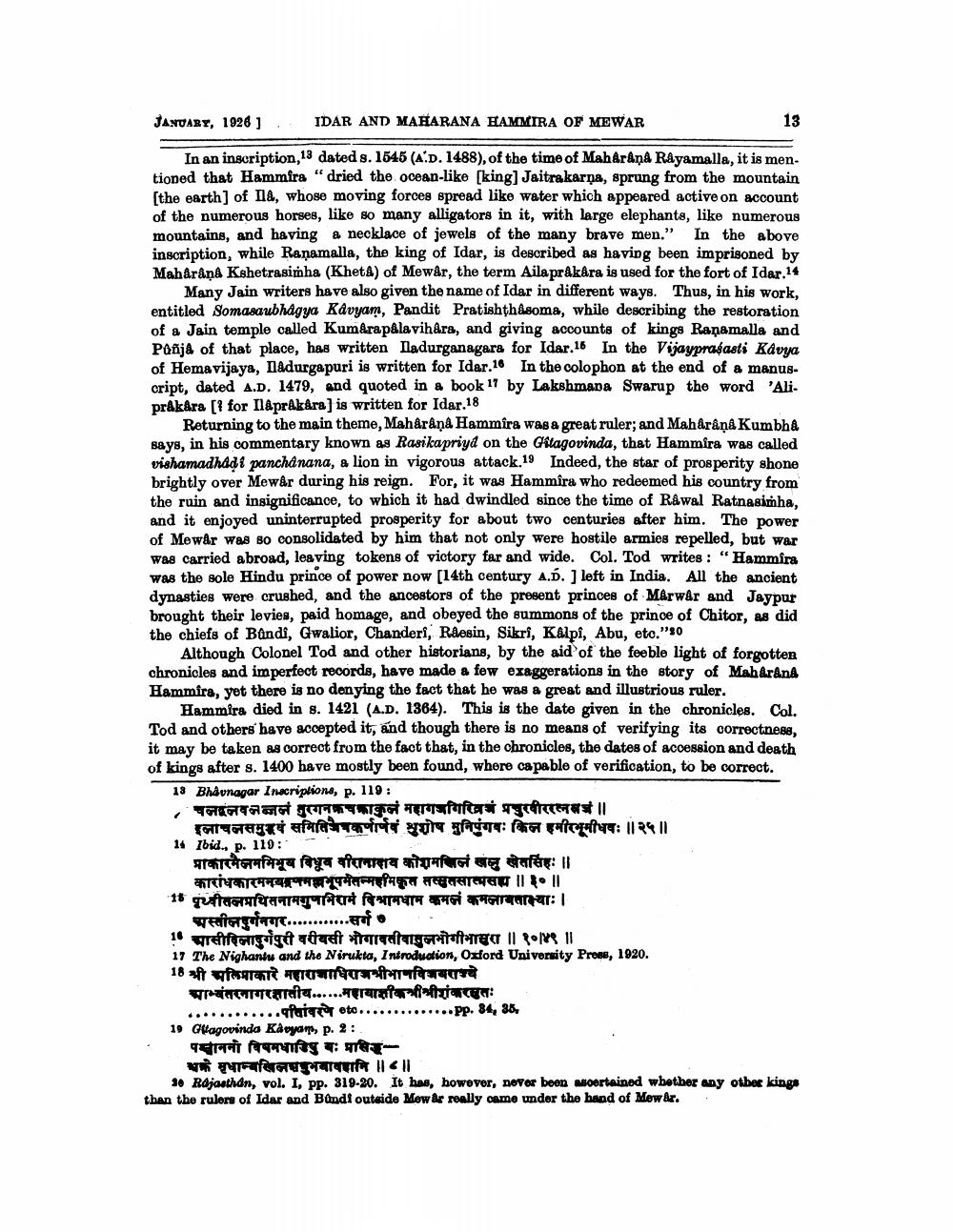________________
JANUARY, 1026 ).
IDAR AND MAĦARANA FAMMIRA OF MEWAR
13
In an inscription, 18 dated s. 1645 (AD. 1488), of the time of Mah Arana Rayamalla, it is men. tioned that Hammira “dried the ocean-like (king) Jaitrakarņa, sprung from the mountain (the earth) of Ila, whose moving forces spread like water which appeared active on account of the numerous horses, like so many alligators in it, with large elephants, like numerous mountains, and having a necklace of jewels of the many brave men." In the above inscription, while Ranamalla, the king of Idar, is described as having been imprisoned by Maharana Kshetrasimha (Kheta) of Mewar, the term Ailaprakára is used for the fort of Idar.14
Many Jain writers have also given the name of Idar in different ways. Thus, in his work, entitled Somasaubhagya Kavyam, Pandit Pratishthåsoma, while describing the restoration of a Jain temple called Kumarapala vihara, and giving accounts of kings Ranamalla and Pañja of that place, has written Ladurganagara for Idar.16 In the Vijayprasasti Kavya of Hema vijaya. Dadurgapuri is written for Idar.16 In the colophon at the end of a manuscript, dated A.D. 1479, and quoted in a book 17 by Lakshmana Swarup the word 'Ali. prakara [? for Il&prAkara) is written for Idar.18
Returning to the main theme, Maharana Hammîra was a great ruler; and Mahåråņá Kumbh & says, in his commentary known as Rasika priyd on the Gitagovinda, that Hammira was called vishamadhadi panchanana, a lion in vigorous attack.19 Indeed, the star of prosperity shone brightly over Mewar during his reign. For, it was Hammira who redeemed his country from the ruin and insignificance, to which it had dwindled since the time of Rawal Ratnasimha, and it enjoyed uninterrupted prosperity for about two centuries after him. The power of Mewar was so consolidated by him that not only were hostile armies repelled, but war was carried abroad, leaving tokens of victory far and wide. Col. Tod writes : "Hammira was the sole Hindu prince of power now [14th century A.. ) left in India. All the ancient dynasties were crushed, and the ancestors of the present princes of Marwår and Jaypur brought their levies, paid homage, and obeyed the summons of the prince of Chitor, as did the chiefs of Bandi, Gwalior, Chanderi, Reesin, Sikri, Kalpi, Abu, eto."90
Although Colonel Tod and other historians, by the aid of the feeble light of forgotten chronicles and imperfect records, have made a few exaggerations in the story of Mah Arana Hammira, yet there is no denying the fact that he was a great and illustrious ruler.
Hammira died in s. 1421 (A.D. 1364). This is the date given in the chronicles. Col. Tod and others have accepted it, and though there is no means of verifying its correctness, it may be taken as correct from the fact that, in the chronicles, the dates of accession and death of kings after s. 1400 have mostly been found, where capable of verification, to be correct. 18 Bhavnagar Inscriptions, p. 119:
चलबलवनब्जनं सुरगनकचकाकुलं महागजगिरिव प्रचुरवीररस्लम।
इलाचनसमुखवं समितियेषकर्णार्णवं शुशोष मुनिपुंगवः किल हमीरभूमीधवः ॥२५॥ 14 Ibid., p. 119:
प्राकारमैलममिभूब विधूब वीरानाक्षय कोशमखिलं खस्नु खेतसिंहः॥
कारांधकारममयाणमभूपर्मतन्महीमकृत सस्पतसात्यसा ॥३०॥ "पृथ्वीतलप्रथितनामगुणभिराम विश्रामधाम कमलं कमलावतास्थाः।
effore............ref . "पासीदिनादुर्गपुरी वरीयसी भोगावतीवातुलभोगीभामरा ॥ २०१९ ॥ 17 The Nighantu and the Nirukta, Introduction, Oxford University Press, 1920. 18 श्री अलिपाकारे महाराजाधिराजश्रीभागविजबराम्चे
Wartarreta......ferunterface
............qfaire eto.............. Pp. 84, 85, 19 Gitagovinda Kaoyans, p. 2:.
पमाननी विषमधारिपुबा प्रसिर
धके सुधान्बखिलधुभवावानि ॥4॥
30 Rajasthan, vol. I, pp. 319-20. It has, however, never been ascertained whether any other king than the rulers of Idar and Bandi outaide Mewer really came under the head of Mewar.




